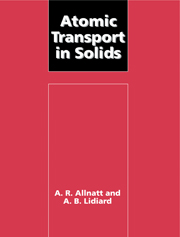Book contents
- Frontmatter
- Contents
- Preface
- List of principal symbols
- 1 Atomic movements in solids – phenomenological equations
- 2 Imperfections in solids
- 3 Statistical thermodynamics of crystals containing point defects
- 4 Non-equilibrium thermodynamics of atomic transport processes in solids
- 5 Some applications of non-equilibrium thermodynamics to solids
- 6 Microscopic theories – the master equation
- 7 Kinetic theory of relaxation processes
- 8 Kinetic theory of isothermal diffusion processes
- 9 The theory of random walks
- 10 Random-walk theories of atomic diffusion
- 11 Transport coefficients of dilute solid solutions – results and applications
- 12 The evaluation of nuclear magnetic relaxation rates
- 13 Theories of concentrated and highly defective systems
- References
- Index
1 - Atomic movements in solids – phenomenological equations
Published online by Cambridge University Press: 28 December 2009
- Frontmatter
- Contents
- Preface
- List of principal symbols
- 1 Atomic movements in solids – phenomenological equations
- 2 Imperfections in solids
- 3 Statistical thermodynamics of crystals containing point defects
- 4 Non-equilibrium thermodynamics of atomic transport processes in solids
- 5 Some applications of non-equilibrium thermodynamics to solids
- 6 Microscopic theories – the master equation
- 7 Kinetic theory of relaxation processes
- 8 Kinetic theory of isothermal diffusion processes
- 9 The theory of random walks
- 10 Random-walk theories of atomic diffusion
- 11 Transport coefficients of dilute solid solutions – results and applications
- 12 The evaluation of nuclear magnetic relaxation rates
- 13 Theories of concentrated and highly defective systems
- References
- Index
Summary
Introduction
The processes of the migration of atoms through solids enter into a great range of other phenomena of concern to solid state physics and chemistry, metallurgy and materials science. The nature of the concern varies from field to field, but in all cases the mobility of atoms manifests itself in many ways and contributes to many other phenomena. The study of this mobility and its physical and chemical manifestations is thus a fundamental part of solid state science, and one which now has a substantial history. Like much else in this science it is for the most part concerned with crystalline solids, although it also includes much which pertains also to glasses and polymers. Unfortunately, it is not possible to treat crystalline and non-crystalline solids together in any depth. The present work, which is concerned with the fundamentals of these atomic transport processes, is thus limited to crystalline solids, although occasionally we can ‘look over the fence’ and see implications for non-crystalline substances. Even with the study of crystalline solids there is a further important sub-division to be made, and that is between atomic movements in good crystal, where the arrangement of atoms is essentially as one expects from the crystal-lattice structure, and in regions where this arrangement is disturbed, as at surfaces, at the boundaries between adjoining grains or crystallites, along dislocation lines, etc. The atomic arrangements in these regions are not by any means without structure, but the structures in question are diverse and far from easy to determine experimentally. Since the basis of much of what we have to say is the assumption that there is a known and regular …
- Type
- Chapter
- Information
- Atomic Transport in Solids , pp. 1 - 49Publisher: Cambridge University PressPrint publication year: 1993
- 1
- Cited by



